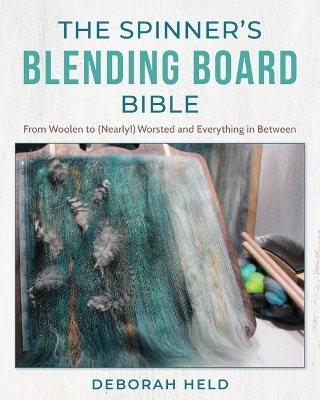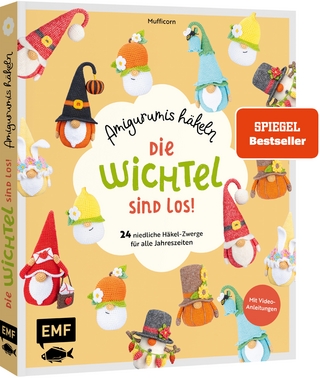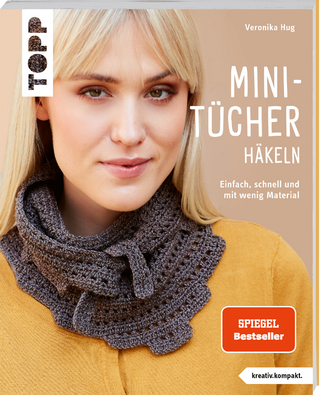
The Spinner's Blending Board Bible
Stackpole Books (Verlag)
978-0-8117-7367-6 (ISBN)
- Noch nicht erschienen (ca. April 2025)
- Versandkostenfrei innerhalb Deutschlands
- Auch auf Rechnung
- Verfügbarkeit in der Filiale vor Ort prüfen
- Artikel merken
As more and more spinners delve into fiber preparation for intentional spinning, the blending board has become more popular than ever before. It’s space efficient, lightweight, and far less costly than investing in expensive blending tools and machinery. While most spinners know that the blending board makes lovely rolags, few are aware of the many other ways it can be used in one’s fiber preparation practices.
In The Spinner’s Blending Board Bible, widely regarded spinning teacher and writer Deborah Held explains the many ways to use a blending board to its fullest capacity. Step by step, she reveals secrets for maximizing the board’s carding and blending properties, providing an as-yet untapped level of know-how for putting the blending board to use in color management, combining fibers and mix-ins, and for creating specific yarn structures in spinning along the woolen and worsted continuum. Beginners and advanced spinners alike will find plenty to learn from her beautiful and instructive photos of fiber, detailed explanations of techniques, and numerous blending “recipes.”
Debbie Held is a freelance writer and international fiber arts educator. She’s a recurring contributor to Spin Off magazine and its blog, PLY Magazine, the SweetGeorgia blog, and more, and she’s the writer behind the former Interweave column, Her Handspun Habit. She teaches courses online for the School of SweetGeorgia, as well as in person throughout the U.S. and abroad. Debbie lives on an urban farm in Atlanta, Georgia, with a Persian cat named Stanley. Both Debbie and Stanley enjoy watching the spinner’s flock of Shetland sheep roaming outside their windows. Write to them (all) at http://debbieheld.com.
Table of Contents
Acknowledgments
Foreword (I will ask one or two friends who are extremely well known in the industry and who have published their own books to write my foreword.)
Introduction
Why the blending board is my go-to, “desert island” tool for fiber processing
Cost
Space
Ergonomics
Nearly limitless uses, including
Rolags (smooth or textured)
Roving (pulled or dizzed)
Batts
More (thoughtful placement of color and texture, such as tweed)
The board’s impact on final yarn in terms of color, scalability, and structure
Adding a few inexpensive items you likely have at home opens a whole new world of possibilities
Reading this book will change the way you see and use your blending board
Chapter I: Your blending board: the all-in-one fiber processing tool
Comparison, including photos, of fiber processing tools: drum carder, hand combs, hand cards
Drum carder [photos of a couple of models]
Best suited for: Blending fibers (textures and colors) well; aeration and loft, great for batts; good for rolags; color play, repeatable results
Cons: expensive (anywhere from a few hundred to thousands of dollars); large footprint; requires mostly minor but ongoing maintenance; unless you have the most costly electric drum carder(s), ongoing use can lead to wear and tear on your spine/neck and shoulder; your blending is limited by the teeth per inch of the cloth on your drum [Graphic: illustration of teeth per inch]
Hand combs and hackle [photos and examples]
Portable; mobile; small footprint
Can blend color and fibers, even repeatables, but only with smooth ingredients
Removes second cuts and smaller pieces of the locks/fiber, then aligns the fiber strands
The results are always smooth/worsted, especially when combined with a diz. Combed and dizzed top is the baseline preparation for a true worsted spin
High-quality combs are costly, and you may require more than one set for the fibers you like to spin
Combing fiber is time consuming
The repetitive movements can put strain on your joints
Hand cards [photos and examples]
Closest to the blending board, IMO, but much smaller. Low footprint, portable, and affordable, and may be used in many ways.
Good for true woolen preparation (the only true woolen prep is a hand-carded rolag), and even for mimicking a combed preparation when the lock of fiber is flick-carded into alignment
You could also card the fiber into alignment and then roll it sideways (cigar style) off the card, or diz a roving off of your hand card.
Good for color blending and for combining textures and fibers
Good for carding almost any fiber—cellulose or wool
You could make punis, puni-style rolags, and actual rolags (each yields a very different result)
The small surface size means that the process can be time consuming, especially if you are working on a garment’s worth of fiber or other large spin
Blending board [with photos]
Affordable, portable, and easily stored in small spaces. Can be moved from area to area within your home with ease. With the adjustable keel attachment, you can adjust the board to the most comfortable angle and even from your most comfortable standing to sitting angle within seconds. The flat surface makes for easier scalable loading, for those who’d like to spin a good amount of fiber that works well together
Excellent for releasing (and discovering) creativity
Holds and blends as much as an average (7–8” wide drum) drum carder
The flat surface allows for intentional placement and loading of fibers and decorative elements
Easy on the body
The alignment of the teeth means that you can replicate a worsted result easily, but you could also card a true roving. With the extra knowledge gained in this book, you can card fiber through the entire spectrum of woolen to worsted prep
Good for fiber play and experimentation, especially since you don’t have to load and entire board’s worth of fiber if you don’t want to
Can replicate any preparation or blend as a drum carder, including gradients, placement of color/texture for a variegated result, true color blending, and more
While different TPI (teeth per inch) are available and are part of selecting the board that’s right for you (see Chapter II), the hidden blending power lies within the accessories you use with it. One board can help you do it all
Accessories and additional tools are affordable and often found lying around the house
Turns fiber prep into fiber play
Most people just don’t realize all the blending board can do, especially since spinners tend to focus more on combs and carders, and which of those they should get first
How to choose the blending board that’s right for you
TPI of cloth
Directionality of the teeth/how this differs from drum carder cloth
Size of the carding cloth
Does it have a keel?
Price
How to DIY your own board (see appendix A for supplies list, schematic and full directions)
List and photos of board makers used in this book (will be using course 48 TPI, standard 72 TPI, 90 and 120 TPI and comparing results)
Chapter 2: Industry secrets for unlocking the hidden powers of your blending board
Brushes
An assortment of brushes picked up around the house, at dollar stores, grocery stores, etc. and how these bristle types make all the difference in the blending/carding of the fibers
Vs. the brush(es) that typically arrive with your purchase
Loading
Order of your fibers and mix-ins
Importance of building up the overhang
Best staple lengths
How much can it hold (and why you shouldn’t overload the board)?
Dowels
Size of typical dowel
Size you should go have cut and the difference this makes
Sanding your dowels for best results
Diz
Styles and materials
Sizes to collect
DIY and other options
Chapter 3: Carded rollups: rolags and batts
These preparations are excellent ways to become comfortable with your blending board
Supplies needed:
Wool
Silk, Tencel, bamboo or other shinies
Angelina and/or sparkle (optional)
Scissors or snips
Bits of fluffy handspun or yarn
Random wool locks
Smooth
Textured
How-to
Gradient
Variegated
Random
Rolling off a batt
Make it a double (batt)
Chapter 4: Roving vs. top
What is roving?
How to create it
Easy way (from a rolag)
From a roLOG
From a batt
Dizzing a roving
How top differs from roving
Replicate a combed top using the blending board
Chapter 5: Totally tweed and other texture
Texture can be subtle or bold, and anywhere in-between
1. Supplies needed:
Wool
Silk noil
Angelina and/or sparkle (optional)
Silk threads
Assortment of locks
Scissors or snips
2. What is tweed?
a. Example #1
b. Example #2
c. Example #3
3. Freeform textures for spinning
a. Example #1
b. Example #2
c. Example #3
Chapter 6: Color play
1. Create a fractal-style spin (3 different ways)
2. Repeating stripes
3. Variegated yarn
4. Color blending
Chapter 7: Scalable blending for large, multi-board projects
Chapter 8: Going off board
Other uses you may never have considered
1. Flick carding locks
2. How to make a carded cloud
3. Batty bumps
Chapter 9: Blended recipes and patterns (4 or 5 total)
Ultimate sock yarn with pattern (top down)
Cabled, tweed vest with pattern
Wacky, woven scarf recipe
Gradient shawl pattern
Textured singles yarn with hat pattern
Appendices
DIY blending board (supplies needed, schematic, instructions)
Comparison chart of all brands of blending boards used in this book (makers to include Ashford, Louet, Daisy, Majacraft, and possibly Clemes and Clemes)
Resources (a list of makers for all items, including fibers, used in this book)
| Erscheint lt. Verlag | 1.4.2025 |
|---|---|
| Verlagsort | Mechanicsburg, Pennsylvania |
| Sprache | englisch |
| Maße | 203 x 254 mm |
| Themenwelt | Sachbuch/Ratgeber ► Freizeit / Hobby ► Handarbeit / Textiles |
| Sachbuch/Ratgeber ► Freizeit / Hobby ► Kreatives Gestalten | |
| ISBN-10 | 0-8117-7367-1 / 0811773671 |
| ISBN-13 | 978-0-8117-7367-6 / 9780811773676 |
| Zustand | Neuware |
| Haben Sie eine Frage zum Produkt? |
aus dem Bereich


